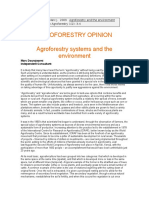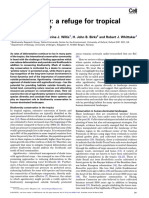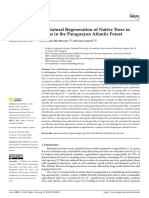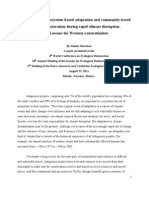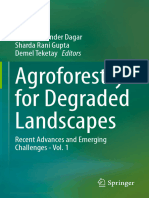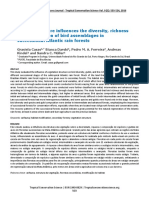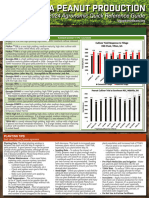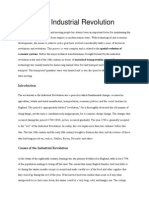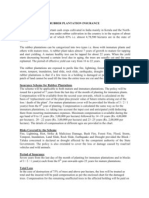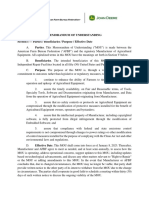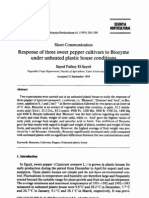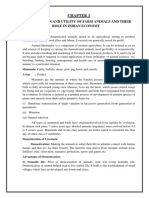0 ratings0% found this document useful (0 votes)
79 viewsA.M. Gordon & S.M. Newman - Temperate Agroforestry Systems
A.M. Gordon & S.M. Newman - Temperate Agroforestry Systems
Uploaded by
Vasco GuerreiroThis book review summarizes the book "Temperate Agroforestry Systems" edited by A.M. Gordon and S.M. Newman. The book brings together case studies on agroforestry systems from regions around the world, including North America, Argentina, Europe, China, Australia and New Zealand. It finds that while tropical agroforestry has received more research attention, temperate agroforestry provides solutions to challenges in natural resource management. The review praises the book for providing a rich global variety of temperate agroforestry practices while avoiding repetition between chapters. However, it notes that more economic analyses and photographs would have strengthened the arguments made. Overall, the review recommends the book for those interested
Copyright:
© All Rights Reserved
Available Formats
Download as PDF, TXT or read online from Scribd
A.M. Gordon & S.M. Newman - Temperate Agroforestry Systems
A.M. Gordon & S.M. Newman - Temperate Agroforestry Systems
Uploaded by
Vasco Guerreiro0 ratings0% found this document useful (0 votes)
79 views2 pagesThis book review summarizes the book "Temperate Agroforestry Systems" edited by A.M. Gordon and S.M. Newman. The book brings together case studies on agroforestry systems from regions around the world, including North America, Argentina, Europe, China, Australia and New Zealand. It finds that while tropical agroforestry has received more research attention, temperate agroforestry provides solutions to challenges in natural resource management. The review praises the book for providing a rich global variety of temperate agroforestry practices while avoiding repetition between chapters. However, it notes that more economic analyses and photographs would have strengthened the arguments made. Overall, the review recommends the book for those interested
Original Description:
Agroforestry
Copyright
© © All Rights Reserved
Available Formats
PDF, TXT or read online from Scribd
Share this document
Did you find this document useful?
Is this content inappropriate?
This book review summarizes the book "Temperate Agroforestry Systems" edited by A.M. Gordon and S.M. Newman. The book brings together case studies on agroforestry systems from regions around the world, including North America, Argentina, Europe, China, Australia and New Zealand. It finds that while tropical agroforestry has received more research attention, temperate agroforestry provides solutions to challenges in natural resource management. The review praises the book for providing a rich global variety of temperate agroforestry practices while avoiding repetition between chapters. However, it notes that more economic analyses and photographs would have strengthened the arguments made. Overall, the review recommends the book for those interested
Copyright:
© All Rights Reserved
Available Formats
Download as PDF, TXT or read online from Scribd
Download as pdf or txt
0 ratings0% found this document useful (0 votes)
79 views2 pagesA.M. Gordon & S.M. Newman - Temperate Agroforestry Systems
A.M. Gordon & S.M. Newman - Temperate Agroforestry Systems
Uploaded by
Vasco GuerreiroThis book review summarizes the book "Temperate Agroforestry Systems" edited by A.M. Gordon and S.M. Newman. The book brings together case studies on agroforestry systems from regions around the world, including North America, Argentina, Europe, China, Australia and New Zealand. It finds that while tropical agroforestry has received more research attention, temperate agroforestry provides solutions to challenges in natural resource management. The review praises the book for providing a rich global variety of temperate agroforestry practices while avoiding repetition between chapters. However, it notes that more economic analyses and photographs would have strengthened the arguments made. Overall, the review recommends the book for those interested
Copyright:
© All Rights Reserved
Available Formats
Download as PDF, TXT or read online from Scribd
Download as pdf or txt
You are on page 1of 2
713
BOOK REVIEW
Temperate Agroforestry Systems
A.M. GORDON and S.M. NEWMAN, Editors
CAB INTERNATIONAL, Wallingford, Oxon OX10 8DE, U.K.; 1997, 270 p, paperback, $50.00, ISBN 0 85199 147 5.
zones may surprise those familiar only with tropical agroforestry. There is certainly a strong emphasis on silvopastoralism,
which means that temperate agroforesters are perhaps more
likely to have expertise in animal nutrition than their tropical
counterparts, though a key to developing effective management strategies for such systems remains control of the partitioning of resources between the trees and understory. Use of
trees for the management of snow cover and protection of
livestock from extreme cold is a feature of agroforestry that is
unique to the temperate zone, but the North American system
of alleycropping with black walnut (Juglans nigra L.) is a
classic of agroforestry system design that utilizes fundamental
principles of agroforestry that are applicable anywhere. The
Australian system of using water consumption by trees to
minimize groundwater recharge under arable land may at first
sight appear counterintuitive to agroforesters used to working
in semiarid regions where excessive water use by trees is often
a constraint on the development of agroforestry; it is, however,
an excellent example of how trees can be used to enhance the
sustainability of agriculture, as it provides a solution to the
very serious problem in Australia of soil salinization by rising
groundwater. The contribution from China highlights the
markedly different set of problems, resulting from high population densities, faced by land-use planners there and shows
how integrating trees into agriculture, using the four sides
system, where trees are planted along roadsides and the
boundaries between small, intensively farmed plots, has enabled production of both food and wood to expand with the
population.
A particularly fascinating feature of each of the contributions to the book is a short survey of the history of agroforestry
in each region. There are many reminders that use of trees on
farms goes back to the beginnings of agriculture. The observations of tree--crop interactions from the Yung Dynasty in China
reported in the book confirm that agroforestry is an ancient
occupation.
Discussion of the implications of plant ecophysiology for
tree--crop interactions and microclimate modification by trees
is limited and likely to be seen as superficial by specialists in
these areas. This is not a serious omission, however, because
these issues are amply covered in other recent texts, but there
is a surprising lack of information----at least beyond qualitative----on the economics of agroforestry. Farming in temperate
zones is very often a highly commercialized enterprise and,
consequently, the arguments presented in favor of agroforestry
would have added conviction if they were supported by clearer
financial and economic analyses.
The information contained in the book is well documented,
making it something of a bibliographic goldmine for researchers in temperate agroforestry. There are, however, in-
TREE PHYSIOLOGY ON-LINE at http://www.heronpublishing.com
Downloaded from http://treephys.oxfordjournals.org/ by guest on December 3, 2015
The large body of research into tropical agroforestry systems
that has accumulated over recent decades may leave some with
the impression that agroforestry is an insignificant practice in
temperate zones. Readers of this book will, however, be left
with no doubt that there is a community of both researchers
and practitioners who are enthusiastic about the potential of
agroforestry to provide solutions for some of the major challenges facing natural resource management in the temperate
regions of the world.
Gordon and Newman have brought together contributions
from scattered regions of the globe, with chapters reviewing
research and development in agroforestry in North America,
Argentina, Europe, China, Australia and New Zealand. Thus,
the organization of the book has a geographical focus, which
has prevented it from becoming another exercise in the listing
and categorization of different systems of agroforestry.
Rather, readers are able to appreciate the great variety of
temperate agroforestry systems in use around the world,
while understanding the diverse agronomic and economic
considerations that have shaped their development on different continents. There are inevitably features common to
agroforestry across the temperate regions, but the editors
have assembled the book with care and there is minimal
repetition among chapters. Effective synthesis of the issues
raised by the various authors is provided in introductory and
concluding chapters, which together with consistent editing
of the text, serve to unify the contributions into a cohesive
volume.
The book focuses on the role of trees in farming systems,
rather than the physical or physiological mechanisms controlling interactions between trees and crops, or criteria for the
selection of species or combinations of species. While reviewing research in agroforestry and discussing the merits of the
most prevalent systems used in the different geographical
regions, each of the contributors has provided an analysis of
how trees can be used to enhance the sustainability of temperate agriculture and improve biodiversity in modern farming,
while maintaining or increasing profitability for farmers. The
book has a firmly academic perspective, but these features
mean that it should also be appreciated by farmers with an
interest in diversifying the management of their farms and by
governmental policy makers in areas such as agriculture, forestry, rural economics and resource conservation. There are
some strong words for politicians intent on reducing public
funding of conservation and resource management programs
in the countryside, particularly in North America, and they
would benefit from awareness of the compelling arguments in
favor of promoting more diversified systems of land use that
are presented in this book.
The rich variety of agroforestry systems used in temperate
714
stances where the reader is left wondering how to obtain
further details on aspects of the text. A glaring example of this
is the un-referenced contention that roots of Paulownia elongata are found mostly below the rooting zone of crops; however, this is more of a reflection on the poor quality of
information available on belowground interactions in agroforestry than the editorial standards of the book.
The book would benefit from the use of more photographs
to illustrate the various systems of agroforestry discussed,
although there are impressive pictures of the use of agroforestry in riparian strips to rehabilitate stream courses in agricultural fields. The choice of the photograph for the front cover,
which shows sheep grazing in a silvopastoral scene, is especially unfortunate, however, because the trees in the picture
have been relegated to a minor detail of the background.
Overall, Gordon and Newman have produced an excellent
book that I recommend to all those with an interest in agroforestry. In time, the book is likely to be seen as an important
synthesis of research in temperate agroforestry and it may,
therefore, galvanize research efforts to become more cohesive
across continents. Research into common areas of interest
could then be coordinated internationally, promoting assessment of the transferability of systems between continents and
coordination of policy development and lobbying for institutional support of temperate agroforestry.
Dr. Mark Smith, Institute of Hydrology, Crowmarsh Gifford,
Wallingford, Oxfordshire OX10 8BB, United Kingdom.
Downloaded from http://treephys.oxfordjournals.org/ by guest on December 3, 2015
TREE PHYSIOLOGY VOLUME 18, 1998
You might also like
- Biodiversity Islands: Strategies For Conservation in Human-Dominated EnvironmentsDocument710 pagesBiodiversity Islands: Strategies For Conservation in Human-Dominated EnvironmentsConstanza Becerra RodasNo ratings yet
- Agroforestry Systems and The EnvironmentDocument4 pagesAgroforestry Systems and The EnvironmentMarc Jean DourojeanniNo ratings yet
- Sustainability 12 07983Document23 pagesSustainability 12 07983Divine Lerre RocacorbaNo ratings yet
- Definition of Agroforestry RevisitedDocument3 pagesDefinition of Agroforestry RevisitedMuhammad AhmadNo ratings yet
- Agroecology: Ecological Processes in Sustainable Agriculture 2000Document3 pagesAgroecology: Ecological Processes in Sustainable Agriculture 2000cynthia ekaNo ratings yet
- 2010 - Book - Soil Biology and Agriculture in The TropicsDocument330 pages2010 - Book - Soil Biology and Agriculture in The TropicsKarol Gonzalez100% (1)
- Agroforestry and Biodiversity Conservation in Tropical LandscapesFrom EverandAgroforestry and Biodiversity Conservation in Tropical LandscapesNo ratings yet
- wild-01-00006Document19 pageswild-01-00006igedeagusnovandaNo ratings yet
- Tropical Fruits and Frugivores PDFDocument262 pagesTropical Fruits and Frugivores PDFFernanda Vivas100% (2)
- Dawson 2013Document24 pagesDawson 2013Karol FernandesNo ratings yet
- On Permaculture and Plant-Animal InteractionsDocument25 pagesOn Permaculture and Plant-Animal InteractionsNathan Podunk RyanNo ratings yet
- Biodiversity Function and Resilience in Tropical Agroforestry Systems Including Shifting CultivationDocument19 pagesBiodiversity Function and Resilience in Tropical Agroforestry Systems Including Shifting CultivationUnan NurNo ratings yet
- A Ap026eDocument20 pagesA Ap026eHuamayun al MamunNo ratings yet
- Reforestacion 1Document4 pagesReforestacion 1Marceliux Cherry SacbeNo ratings yet
- Trade-Offs Between Cattle Production and Bird ConsDocument13 pagesTrade-Offs Between Cattle Production and Bird ConsJuan Cruz CalviNo ratings yet
- Mcintyre - Habitat Variegation, An Alternative To Fragmentation PDFDocument3 pagesMcintyre - Habitat Variegation, An Alternative To Fragmentation PDFivanNo ratings yet
- J Agsy 2010 03 007Document1 pageJ Agsy 2010 03 007hisij20609No ratings yet
- Chapter 5 - Agro-Forestry Agro-Forestry, A New Fashion of Old TraditionDocument13 pagesChapter 5 - Agro-Forestry Agro-Forestry, A New Fashion of Old TraditionChaitanya BandaruNo ratings yet
- Journal Agroforestry Agroforestry For Biodiversity Bhagwat2008Document7 pagesJournal Agroforestry Agroforestry For Biodiversity Bhagwat2008Inkorena SukartonoNo ratings yet
- Phillips 1994Document24 pagesPhillips 1994gina saenzNo ratings yet
- Literature Review On DesertificationDocument6 pagesLiterature Review On Desertificationc5praq5p100% (1)
- tmp2720 TMPDocument17 pagestmp2720 TMPFrontiersNo ratings yet
- Growing Good Tropical Trees For Planting: Commonwealth Science CouncilDocument252 pagesGrowing Good Tropical Trees For Planting: Commonwealth Science CouncilangeleduardomorenoalboresNo ratings yet
- Flores Et Al. - 2018 - Intraspecific Variation in Pines From The Trans-Mexican Volcanic Belt Grown Under Two Watering Regimes ImplicatioDocument17 pagesFlores Et Al. - 2018 - Intraspecific Variation in Pines From The Trans-Mexican Volcanic Belt Grown Under Two Watering Regimes Implicatiofoga12No ratings yet
- Watershed ManagementDocument20 pagesWatershed ManagementestelauNo ratings yet
- Research, Views, Practices, Policy and TechnologyDocument13 pagesResearch, Views, Practices, Policy and TechnologyRicardo RussoNo ratings yet
- Patil Et Al. 2021 - Agroforestry Book ChapterDocument19 pagesPatil Et Al. 2021 - Agroforestry Book Chaptersbpatil84_885356542No ratings yet
- Cooper24-Amazon Tree AbundanceDocument22 pagesCooper24-Amazon Tree Abundancearethabeckman14No ratings yet
- SSRR Series 24Document48 pagesSSRR Series 24Alihasen Yacob DebisoNo ratings yet
- Forests 13 02045 v2 2Document15 pagesForests 13 02045 v2 2FIRE ParaguayNo ratings yet
- Tropical Tree PhysiologyDocument464 pagesTropical Tree PhysiologyMiguelSalamanca100% (2)
- Silviculture: A Key To Sustainable Forest Management Unasylva 181: 2Document2 pagesSilviculture: A Key To Sustainable Forest Management Unasylva 181: 2Carlos Andres VásquezNo ratings yet
- Wiley Ecological Applications: This Content Downloaded From 14.139.86.226 On Mon, 25 Jul 2016 12:53:42 UTCDocument5 pagesWiley Ecological Applications: This Content Downloaded From 14.139.86.226 On Mon, 25 Jul 2016 12:53:42 UTCrohitNo ratings yet
- Ecmed 0153-8756 2015 Num 41 1 1251 t3 0089 0000 3Document3 pagesEcmed 0153-8756 2015 Num 41 1 1251 t3 0089 0000 3jaoua.celleNo ratings yet
- Tropical Agroforestry Systems and Practices - Usaid PDFDocument39 pagesTropical Agroforestry Systems and Practices - Usaid PDFariffaridaNo ratings yet
- Lecture 5 + 6Document15 pagesLecture 5 + 6nienke.geerts.96No ratings yet
- Arbustos - 176488782-1Document9 pagesArbustos - 176488782-1burghivictorNo ratings yet
- Inigenous Knowledge and Environmental Conservation in East AfricaDocument47 pagesInigenous Knowledge and Environmental Conservation in East AfricaAdonias GeraldNo ratings yet
- Mixed-Species Versus Monocultures in Plantation Forestry: Development, Benefits, Ecosystem Services and Perspectives For The Future. AcknowledgementsDocument6 pagesMixed-Species Versus Monocultures in Plantation Forestry: Development, Benefits, Ecosystem Services and Perspectives For The Future. AcknowledgementsJayhan AmbrocioNo ratings yet
- Art 13-15Document528 pagesArt 13-15ErudíhenNo ratings yet
- The Ecology of Neotropical Savannas-Harvard University Press (1984 Guillermo Sarmiento - Otto Solbrig - )Document253 pagesThe Ecology of Neotropical Savannas-Harvard University Press (1984 Guillermo Sarmiento - Otto Solbrig - )caranpaimaNo ratings yet
- Dennis Martinez (2011)Document12 pagesDennis Martinez (2011)Jane Marina ApgarNo ratings yet
- 2020_Book_AgroforestryForDegradedLandsca (2)Document560 pages2020_Book_AgroforestryForDegradedLandsca (2)marinagfigueiredoNo ratings yet
- Why Forests? Why Now?: The Science, Economics, and Politics of Tropical Forests and Climate ChangeFrom EverandWhy Forests? Why Now?: The Science, Economics, and Politics of Tropical Forests and Climate ChangeNo ratings yet
- Agroforestry Systems For Sustainable Livelihoods ADocument167 pagesAgroforestry Systems For Sustainable Livelihoods AMarco DI MariaNo ratings yet
- Conservation Biology - 2017 - Novotny - Research and Conservation On An Artificial Island in A Shipping Lane and ElsewhereDocument7 pagesConservation Biology - 2017 - Novotny - Research and Conservation On An Artificial Island in A Shipping Lane and Elsewherealishayaseen2019No ratings yet
- The Fragmented Forest: Island Biogeography Theory and the Preservation of Biotic DiversityFrom EverandThe Fragmented Forest: Island Biogeography Theory and the Preservation of Biotic DiversityNo ratings yet
- Advances in Forage Legumes - Shrub LegumesDocument26 pagesAdvances in Forage Legumes - Shrub LegumestcharambiraNo ratings yet
- Gallery Springer 2014 PDFDocument23 pagesGallery Springer 2014 PDFarreeNo ratings yet
- Habitat Structure Influences The Diversity, Richness and Composition of Bird Assemblages in Successional Atlantic Rain ForestsDocument22 pagesHabitat Structure Influences The Diversity, Richness and Composition of Bird Assemblages in Successional Atlantic Rain ForestsLuis Miguel Garrido GonzálezNo ratings yet
- OJE_2013112614464348Document7 pagesOJE_2013112614464348lainefrancisco016No ratings yet
- Darwinian Agriculture: How Understanding Evolution Can Improve AgricultureFrom EverandDarwinian Agriculture: How Understanding Evolution Can Improve AgricultureNo ratings yet
- Rangeland Resource ScienceDocument10 pagesRangeland Resource Sciencesarayu alluNo ratings yet
- Abm 211 Agroforestry Lecture NoteDocument22 pagesAbm 211 Agroforestry Lecture NotemhoonomgberboNo ratings yet
- Costa Et Al. (2022)Document21 pagesCosta Et Al. (2022)Alexandre GonçalvesNo ratings yet
- Plant Roots: Understanding Structure and Function in An Ocean of ComplexityDocument6 pagesPlant Roots: Understanding Structure and Function in An Ocean of ComplexityEthan BalakrishnanNo ratings yet
- Research ArticleDocument16 pagesResearch ArticleBekelu TesemaNo ratings yet
- The Grassy Ecosystems of Madagascar in Context: Ecology, Evolution, and ConservationDocument22 pagesThe Grassy Ecosystems of Madagascar in Context: Ecology, Evolution, and ConservationccasaverdeNo ratings yet
- Principles of Tropical AgronomyDocument245 pagesPrinciples of Tropical Agronomyapi-279376651100% (1)
- Management of Teak PlantationsDocument55 pagesManagement of Teak Plantationsসপ্তক মন্ডল100% (1)
- Geography SBADocument12 pagesGeography SBADominic Lopez100% (1)
- UGA Peanut Agronomic 2024Document4 pagesUGA Peanut Agronomic 2024fondenchiapassedatuNo ratings yet
- The Industrial RevolutionDocument9 pagesThe Industrial RevolutionChetanya MundachaliNo ratings yet
- Rubber InsuranceDocument2 pagesRubber Insurancechaitanya_scribdNo ratings yet
- NOTESDocument10 pagesNOTESPerajothi PalanirajaNo ratings yet
- Title Defense 2020Document20 pagesTitle Defense 2020Ray EmmanuelNo ratings yet
- Organic CertificationDocument7 pagesOrganic CertificationShruti AgarwalNo ratings yet
- My Retirement Plan (Reflection Paper)Document13 pagesMy Retirement Plan (Reflection Paper)CARL ZEUS TOLENTINONo ratings yet
- Response of Newly Collected Acetobacter Isolates in Sweet Corn (Zea Mays L. Saccharata)Document5 pagesResponse of Newly Collected Acetobacter Isolates in Sweet Corn (Zea Mays L. Saccharata)HARI NARAYANNo ratings yet
- Rural Development NotesDocument11 pagesRural Development NotesFajr AdilNo ratings yet
- IBPS SO Agriculture Field Officer AFO Mains 2018 Memory Based 1Document17 pagesIBPS SO Agriculture Field Officer AFO Mains 2018 Memory Based 1lokeshpathologistNo ratings yet
- Chapter-2 Stepup Science Class 1 QPDocument5 pagesChapter-2 Stepup Science Class 1 QPminalNo ratings yet
- English PlustwoDocument33 pagesEnglish PlustwoJesmy V S100% (1)
- Livestock Production and ManagementDocument238 pagesLivestock Production and ManagementMadhav ParatkarNo ratings yet
- Cactus For KidsDocument2 pagesCactus For KidsMark AshNo ratings yet
- Agricultural InputsDocument94 pagesAgricultural InputsRAKSHIT JAINNo ratings yet
- Assessing Water Footprint of Crops Cultivation in Sulaymaniyah, Kurdistan Region of Iraq: Towards An Improvement of Water Efficiency During Drought ConditionsDocument98 pagesAssessing Water Footprint of Crops Cultivation in Sulaymaniyah, Kurdistan Region of Iraq: Towards An Improvement of Water Efficiency During Drought Conditionshushiar100% (2)
- Hydroponics Possible Questions and AnswersDocument2 pagesHydroponics Possible Questions and AnswersgransdencherylNo ratings yet
- SEBI Grade A 2022 Phase 1 Paper 1 Previous Year PaperDocument45 pagesSEBI Grade A 2022 Phase 1 Paper 1 Previous Year PaperNishit KumarNo ratings yet
- Experimental DesignDocument6 pagesExperimental DesignVann MantawidNo ratings yet
- Read The Memorandum of Understanding From Deere & Co.Document6 pagesRead The Memorandum of Understanding From Deere & Co.Michael JohnsonNo ratings yet
- Bio DisealDocument5 pagesBio DisealLayuger Acu LlessojNo ratings yet
- IRRIGATION Notes PDFDocument77 pagesIRRIGATION Notes PDFniteshNo ratings yet
- Kaedah Penanaman Cili FertigasiDocument6 pagesKaedah Penanaman Cili FertigasihyecallNo ratings yet
- SBI Rural Business PO Exam 18-04-2010 Solved Question PaperDocument37 pagesSBI Rural Business PO Exam 18-04-2010 Solved Question PaperGhanshyam ShahNo ratings yet
- Open Record ViewDocument161 pagesOpen Record ViewfaradayzzzNo ratings yet
- LPM5.1TheoryDocument137 pagesLPM5.1TheoryDendenGalitNo ratings yet
- PechaysDocument15 pagesPechaysTheKnow04100% (2)
- 2010 UPLB Annual ReportDocument36 pages2010 UPLB Annual ReportUPLB Office of the Vice Chancellor for Research and Extension100% (1)

